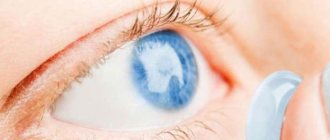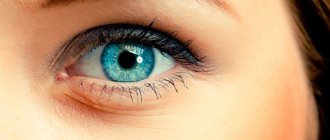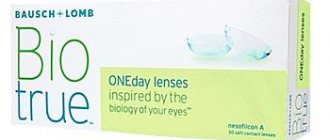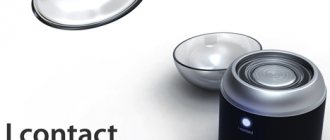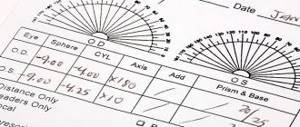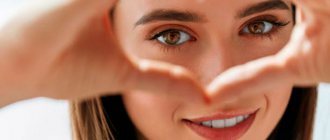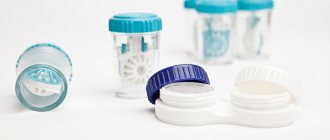The Linzy.ru team will tell you how the radius of curvature influences the choice of contact lenses, what this parameter is and why you need to know it. Please note that for its correct determination, consultation with an ophthalmologist is required.
The radius of curvature of the inner surface of the lens, or “base curvature” for short, is a parameter that ensures its comfortable fit on the eye. The value is designated BS or BC and is indicated on the original packaging. The radius should correspond to the curvature of the cornea. Since each person has a different structure of the eyeball, the amount of curvature will be different. If the radius of the lens is smaller, it will cause discomfort, squeezing the blood vessels of the eye and blocking the access of oxygen to the tissues. Redness and tearing may occur. A lens with a larger radius may fall out when the eyelids move (blink) as it will not be securely fixed. In this case, there is “rubbing” of the eye and a blurry image. To avoid such unpleasant sensations, it is necessary to accurately select the size of the corrective agent, taking into account the individual characteristics of the eye.
If BS is too small
When the lens fits too tightly around the cornea, it compresses the blood vessels, causing the eyes to become red. Tear exchange is disrupted, since tear fluid cannot pass freely under the lens, making oxygen access to the eye difficult. All this can lead to instability of vision and inflammatory diseases. Keratitis or hypoxia may develop (especially when using hydrogel models, since their level of oxygen permeability is lower than that of silicone hydrogel models).
So, you have probably already concluded how to choose the radius of curvature of contact lenses. This should always be done only by a trained specialist. Do not try to buy or order contact correction products without a preliminary diagnosis from a contact specialist - incorrectly selected lenses can cause serious harm to your eyes.
MagazinLinz.ru team
Tags: Contact lenses Articles
How to find out the radius of curvature of contact lenses?
To determine this value, be sure to consult an ophthalmologist (optometrist). He will select the necessary adjustment for you. The procedure consists of several stages:
• determination of vision parameters using a special device (autorefractometer); • trying on several trial lens options; • checking the fit of the lens using a slit lamp and ultraviolet light.
What does the radius of curvature of contact lenses affect:
• wearing comfort; • image clarity; • correct fit of the optical product on the eye; • ensuring normal blood supply, access of oxygen and natural tear lubrication to the cornea.
The most common type of contact lenses are spherical BC 8.6 and BC 8.7. Today, manufacturers produce aspherical contact correction products and multifocal ones, which are designed to combat age-related changes in the retina. In addition, there are toric lenses to correct astigmatism. Such vision is characterized by a “blurred picture” of surrounding objects due to disruption of the shape of the lens, cornea or eye. These lenses have a complex geometric shape and have special properties (thin and thick areas, truncation of the lower part, ballast, reversible prism) that allow complete correction of astigmatic vision.
Acuvue Oasys with 8.4 curvature and Adria Color with 8.6 curvature
Parameters and types of contact lenses (answers to frequently asked questions)
What is the radius of curvature and what does it affect?
The base radius is a characteristic of the curvature of the optical zone of the rear surface of the lens, measured in millimeters. This parameter affects the fit of the lens on the eye. If this parameter is selected incorrectly, the contact lens may cause discomfort.
If the radius of curvature of the previous lenses was 8.3, is it possible to buy new ones with a curvature of 8.5?
The radius of base curvature of contact lenses is important, but not the only parameter of contact lenses. The fit of lenses on the eye is also affected by the material, design, thickness and other parameters of the lens, so switching to lenses with other parameters on your own without selecting them from a specialist is not recommended.
What lenses can you recommend for me?
Which lenses are better?
To select contact lenses, you need to contact a specialist in contact vision correction in optics.
I bought contact lenses (without a prescription) and they don't fit. What should I do?
Wearing these lenses is not recommended. It is necessary to contact an optical specialist to select new contact lenses.
My vision has become worse and I want to increase the diopter by 0.5. Do you think it's okay?
It is strictly not recommended to change the optical power parameters of a contact lens yourself. Self-prescription may lead to vision impairment. Seek advice from a specialist in contact vision correction.
What is the difference between 1-DAY ACUVUE®MOIST and 1-DAY ACUVUE® TruEye®? Is it possible to switch from one lens to another without selecting a doctor?
It is not recommended to switch from one lens to another without consulting a specialist. The main difference lies in the properties of the materials of these contact lenses.
The 1-DAY ACUVUE contact lens is made from a hydrogel material with a high moisture content. LACREON® technology allows you to embed a moisturizing component into the lens material so that it remains in it throughout the entire wearing period, ensuring comfortable wearing. The hydrogel material in the 1-DAY ACUVUE® MOIST lens allows sufficient oxygen to reach the cornea and provides UV protection*. These lenses can be worn comfortably for up to 12 hours a day.
Unlike the 1-DAY ACUVUE® MOIST, the 1-DAY ACUVUE® TruEye® lens is made of silicone hydrogel material, which provides 100% oxygen to the cornea. HYDRACLEAR® technology has created an ultra-smooth contact lens with an internal moisturizing component that does not feel like the lens is on your eyes when worn. They have the highest level of UV protection*. These lenses can be worn comfortably for 14 hours or more per day.
If I have astigmatism, why can't I wear regular lenses?
You can wear regular, spherical lenses, but they will not be able to provide you with 100% clarity of vision, which will cause discomfort. For complete correction and clear vision, you need to select toric lenses designed to correct astigmatism with a specialist.
Traditional and daily contact lenses: how to choose the radius of curvature?
When purchasing contact vision correction products, follow the recommendations of your ophthalmologist. Keep in mind that your prescription for contact lenses is different from your prescription for glasses. Use the filter on the Linzy.ru website to select the parameters you need. The optical power (dioptres), radius and base curvature BS (BC) must match those specified in your prescription. The deviation of the BS (BC) indicator is allowed within 0.2 units. Thus, Acuvue Advance have BS (BC) from 8.3 to 8.7. The Acuvue TruEye has a base curvature ranging from 8.5 to 9.0, while the Optima FW can be found with a BC from 8.3 to 9.0. Properly selected contact correction products guarantee good vision and comfort. Order colored and carnival, toric and multifocal lenses from the catalog of our online store. In order for the lenses to work correctly for the entire period specified by the manufacturer, they must be cleaned and stored in a special solution in a closed container. We are pleased to offer you disinfectant solutions, special care liquids (shampoos) and drops that eliminate dry eyes from Sauflon, Alcon, Bausch & Lomb.
What are the diameters of contact lenses?
Optics manufacturers produce lenses of several diameters - from 13.6 to 14.5 mm. The most common values range from 13.8 to 14.5 mm. Models of these sizes are produced most often, since they fit the standard parameters of the cornea of our eyes. However, other characteristics are also of great importance for the selection of lenses: the radius of curvature of the cornea, the width of its sliding zone, the type and degree of pathology. For complex models—multifocal or toric—the values of the optical power of the cylinder and its axis are also important.
How to determine that the lenses are chosen correctly?
It is almost impossible to choose the correct fit of an optical product on your own. Therefore, it is worth seeking professional help from a clinic. Soft lenses should be located exactly in the middle of the eye, completely cover the iris and protrude beyond it by about one and a half millimeters.
When the eyeballs move, they can move up to 1.5 mm. If you lift the eyepiece up through the skin of the lower eyelid, it should instantly and without obstacles return to its original position. This type of testing is called push-up testing.
Contact lenses: radius of curvature - what is it?
To make the use of contact lenses comfortable and safe for eye health, it is very important to take into account the individual characteristics of the cornea and select the correct optical products. The radius of curvature is one of the most important characteristics of lenses. Let's figure out how to choose lenses with this parameter.
The radius of curvature of a contact lens is a parameter that indicates the curvature of the surface of the product. As a rule, on the packaging it is designated BS or BC. This value is strictly individual and depends on the shape and size of the eyeball. The most common indicator is 8.6. As is correct, the most popular lenses on the market have a radius from 8.3 to 8.9.
Popular lenses Air Optix Aqua, with a radius of curvature of 8.6, and 1-Day Acuvue TruEye with radii of 8.5 and 9.0
How to find out the radius of curvature of contact lenses that are right for you? To do this, you will need to consult an ophthalmologist. He will conduct a comprehensive diagnosis of your vision using specialized equipment. The procedure lasts only a few minutes and is called autorefractometry. With its help, a specialist will be able to select lenses that are ideal for you. During this process, the examination of the retina of the eye reveals the degree of refraction and astigmatism, if the patient suffers from such a disease.
It is very important to understand what the radius of curvature of contact lenses affects. Since this parameter is responsible for the correct fit of the optical product on the eye, it must be determined very precisely. For this reason, it is strongly recommended not to choose lenses for your eyes without the advice and prescription of a specialist. Otherwise, the position of the product on the cornea will be incorrect, which will cause not only discomfort, but also distortion of the image, and subsequently deterioration of vision. Ophthalmologists allow a deviation of the radius of curvature of a maximum of 0.2; if the size of your contact lenses purchased before the consultation exceeds the permissible value, then the use of such products is strictly not recommended. Symptoms that can be caused by wearing incorrectly selected lenses: itching, inflammation, irritation and redness of the eyes, pain when blinking, decreased visual acuity, headache.
Often, a patient, having in his hands an extract of a computer study, which indicates the radius of curvature of the cornea, for example, 8.0, may mistakenly think that this is exactly the parameter that the lens should have. However, this is not the case; these values cannot coincide, since there is no direct correlation. This is the reason why your doctor writes you a prescription. In addition to this value, lenses have many other equally important parameters that need to be taken into account when purchasing them.
As soon as you have received a prescription for contact lenses, you already know how to choose the radius of curvature, you can safely order the products.
Remember that not only correctly selected lens parameters provide comfort while wearing them, but also proper care. Disinfecting solutions and containers for storing lenses, as well as various moisturizing gels and drops will help you in this matter.
The online contact lens store offers a huge selection of optical products and related products. You can buy the necessary products right now, just fill out an application and select a delivery method.
MagazinLinz.ru Team
Tags: Acuvue Air Optix Accessories Drops Solutions Articles
What is the radius of curvature of a lens?
This is a parameter that is used to determine the bend of the eyepiece from the inside, i.e. where it is in direct contact with the surface of the eye. So that when wearing optics a person does not experience discomfort, it is important that the lens fits as tightly as possible to the cornea and practically follows its contours. Therefore, the radius of curvature should be as close as possible to the anatomical characteristics of the anterior part of the eyeball.
Carefully study the packaging of the eyepieces; manufacturers display data on the main parameters of the lenses on it. The curvature is hidden behind the BS or BC coding; millimeters are used for measurement. Some models have a curvature that gradually increases from the central zone to the periphery. Such eyepieces are most often prescribed to patients suffering from astigmatism. As a rule, two parameters are prescribed on them at once: the maximum and minimum curvature index.
Diameters of decorative contact lenses
In the category of color optics, models of increased diameter are produced, which are designed to create a visual effect. Here is the diameter of decorative lenses:
- 14.0-14.2 mm - models suitable for daily wear and slightly enlarging the eyes;
- 14.5 mm - this diameter of contact lenses gives the eyes a certain “doll-like” appearance, making them wide and open, attracting attention;
- 14.8-15.0 mm - such models are used for cosplay, anime parties, creative photo shoots, and carnivals.
When choosing such optics you need to be careful. You should not purchase lenses with a diameter that is too large for the first time, especially dark shades. You should start with average values to evaluate how they look on your eyes. There is one more nuance that should be taken into account when choosing. For example, the FreshLook Colors model with a diameter of 14.5 mm from Alcon (USA) will look visually different than lenses from Korean brands. So, the stated 14.5 mm for Freshlook is the diameter of the entire lens along with the transparent rim around it, and the colored area inside it has a size of approximately 13.8 mm. But South Korean manufacturers indicate the size of the entire sealed zone as a diameter value, so even 14.2 mm models will provide an enlarging effect for a standard-sized cornea.
The website MagazinLinz.ru presents lenses with a diameter of 14.2 to 14.5 mm, which visually enlarge the eyes. These are popular tint and color models Adria Glamorous, Illusion Fashion, Hera, OKVision Fusion, Air Optix Colors and others.
There is another special category of lenses - scleral. Their diameter is 22-24 mm, and such models cover the entire eye completely. They are intended for short-term use - no more than two hours at a time, then they must be removed. Since the access of oxygen to the eye tissues in such models is very difficult, corneal hypoxia and inflammation may occur. Scleral lenses usually come in black, red or white, sometimes with a pattern on the colored area, and are designed to create a scary, mystical image. Popular models include Adria Sclera-Pro. They are packaged in glass bottles of 1 piece. You should first consult with your ophthalmologist about the advisability of wearing scleral optics - they are not recommended for people with increased dryness or irritability of the visual organs.
